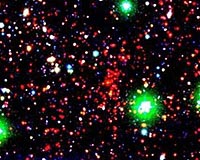 |
San Marcos TX (SPX) Jul 07, 2009 Famed Norwegian artist Edvard Munch (1863-1944) has long been a favorite of Texas State University-San Marcos faculty members Don Olson and Russell Doescher. In 2003, the physics department researchers connected the blood-red sky of Munch's anguished masterpiece "The Scream" to the 1883 eruption of Krakatoa on the other side of the globe. They turned their attention to Munch's beloved painting "Girls on the Pier" in 2006, firmly identifying the yellow orb in the sky as the Moon - not the Sun, as some had theorized - and used simple physics to explain why the Moon cast no reflection on the waters. For an encore, Olson and Doescher, along with Texas State Honors Students Joseph Herbert, Robert Newton, and Ava Pope, apply their forensic astronomy tools to three of Munch's masterworks, identifying the time and place of their creation - a one-month period in Asgardstrand, Norway, when some historians had traditionally believed Munch out of the country. The Texas State researchers' findings are published in the August 2009 issue of Griffith Observer magazine, and an account of their research in Norway will appear in the August 2009 issue of the Norwegian magazine Astronomi. "We were investigating Munch's 1893 painting "Starry Night" and discovered that two other Munch paintings - 'The Storm' and 'Sunrise in Asgardstrand' - featured the same settings and also had been dated to that year," Olson explained. "Several chronologies of Munch's life place him in Germany at this time. One biography goes so far as to say, 'Summer came, and Munch had neither the money nor the inclination to go to Norway.' But we discovered a memoir by Jens Thiis, a long-time friend of the artist, which places him and Munch together in Asgardstrand on August 17, 1893." With a starting date established, the team began the task of identifying various celestial objects in the three paintings. The Texas State team traveled to Norway to locate the painting sites, using precise topographic measurements and computer calculations. The resulting data convincingly tied Munch's three paintings to his previously undocumented visit to Asgardstrand. In "Starry Night," a particularly bright "star" above the horizon long held by previous scholars to be the planet Venus was identified as the planet Jupiter instead (Venus remained out of sight, below the horizon at this time of year). Similarly, a vertical white line visible among shadowy trees, previously identified as a reflection of the hidden Moon, was revealed as a flag pole, clearly pictured in vintage photographs uncovered by the Texas State team in the archives of a local history expert. With Munch's ominous "The Storm," the researchers sifted through Norwegian weather records to discover that the painting must depict the unusually strong thunderstorm that hit Asgardstrand on the evening of Aug. 19, 1893. Thiis' memoir also includes mention of the storm, identifying the gathering of women as fishermen's wives worried about their husbands. Thiis also writes: "The next day, Munch painted the events in his famous picture 'The Storm'... The house with the illuminated windows is the hotel where we stayed, and the woman in white in the foreground is my future wife." With the date and directions now known, the Texas State researchers were able to identify the single star in the upper right corner of the painting as Arcturus, the second-brightest star in the Norwegian night sky after Sirius. Finally, for "Sunrise in Asgardstrand" the precise position of the rising Sun and the glitter path reflecting in the fjord provided another piece of evidence confirming Munch's presence in Norway at the end of the summer of 1893. Using landmarks in the painting as a guide, the researchers determined the exact house and room affording Munch the view he subsequently painted. "We realized that we were standing on the same floorboards by the same window where the artist himself had looked out to watch the rising Sun, more than 100 years ago," Pope said. Munch could only have observed the Sun rising at this particular position during the second week of April - a time when he was documented as being in Germany - or the first five days of September. Since Munch was established as making a late-August visit to Asgardstrand, the early September date dovetails nicely with the other accumulated evidence. "It is pretty clear that Munch started from observations of nature during this visit to Asgardstrand, but then he showed his artistic genius by expressing emotional content that goes beyond literal depictions," Olson said. "Knowing the details of the celestial scenes in these paintings only increases our admiration of the artist's skill at portraying the summer skies of Norway." Share This Article With Planet Earth
Related Links Texas State University-San Marco Astronomy News from Skynightly.com
 Largest Ever Survey Of Very Distant Galaxy Clusters Completed
Largest Ever Survey Of Very Distant Galaxy Clusters CompletedRiverside CA (SPX) Jul 03, 2009 An international team of researchers led by a UC Riverside astronomer has completed the largest ever survey designed to find very distant clusters of galaxies. Named the Spitzer Adaptation of the Red-sequence Cluster Survey, "SpARCS" detects galaxy clusters using deep ground-based optical observations from the CTIO 4m and CFHT 3.6m telescopes, combined with Spitzer Space Telescope infrared ... read more |
|
| The content herein, unless otherwise known to be public domain, are Copyright 1995-2009 - SpaceDaily. AFP and UPI Wire Stories are copyright Agence France-Presse and United Press International. ESA Portal Reports are copyright European Space Agency. All NASA sourced material is public domain. Additional copyrights may apply in whole or part to other bona fide parties. Advertising does not imply endorsement,agreement or approval of any opinions, statements or information provided by SpaceDaily on any Web page published or hosted by SpaceDaily. Privacy Statement |